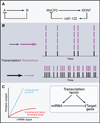Roles for microRNAs in conferring robustness to biological processes
- PMID: 22541426
- PMCID: PMC3351105
- DOI: 10.1016/j.cell.2012.04.005
Roles for microRNAs in conferring robustness to biological processes
Abstract
Biological systems use a variety of mechanisms to maintain their functions in the face of environmental and genetic perturbations. Increasing evidence suggests that, among their roles as posttranscriptional repressors of gene expression, microRNAs (miRNAs) help to confer robustness to biological processes by reinforcing transcriptional programs and attenuating aberrant transcripts, and they may in some network contexts help suppress random fluctuations in transcript copy number. These activities have important consequences for normal development and physiology, disease, and evolution. Here, we will discuss examples and principles of miRNAs that contribute to robustness in animal systems.
Copyright © 2012 Elsevier Inc. All rights reserved.
Figures





References
-
- Acar M, Mettetal JT, van Oudenaarden A. Stochastic switching as a survival strategy in fluctuating environments. Nat. Genet. 2008;40:471–475. - PubMed
Publication types
MeSH terms
Substances
Grants and funding
LinkOut - more resources
Full Text Sources
Other Literature Sources
Molecular Biology Databases

